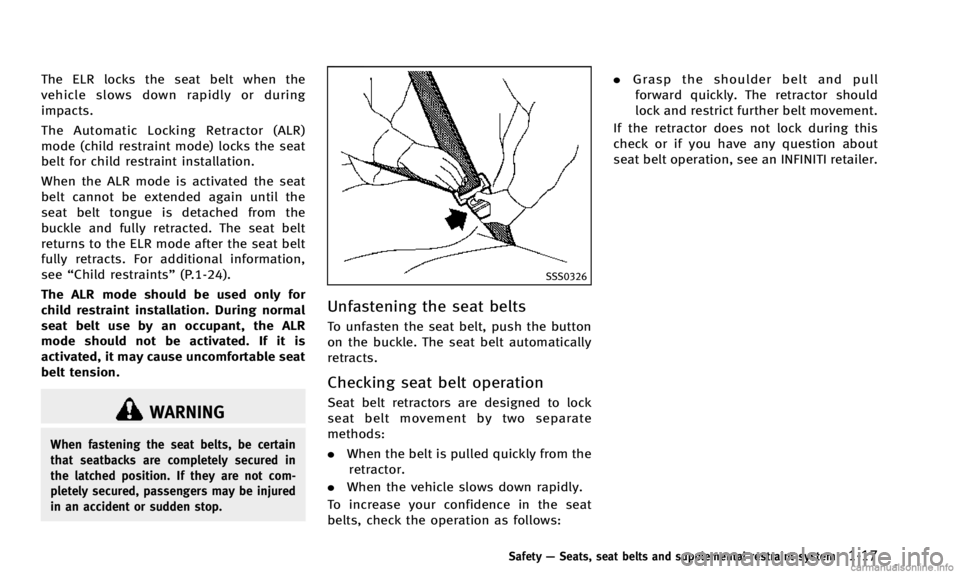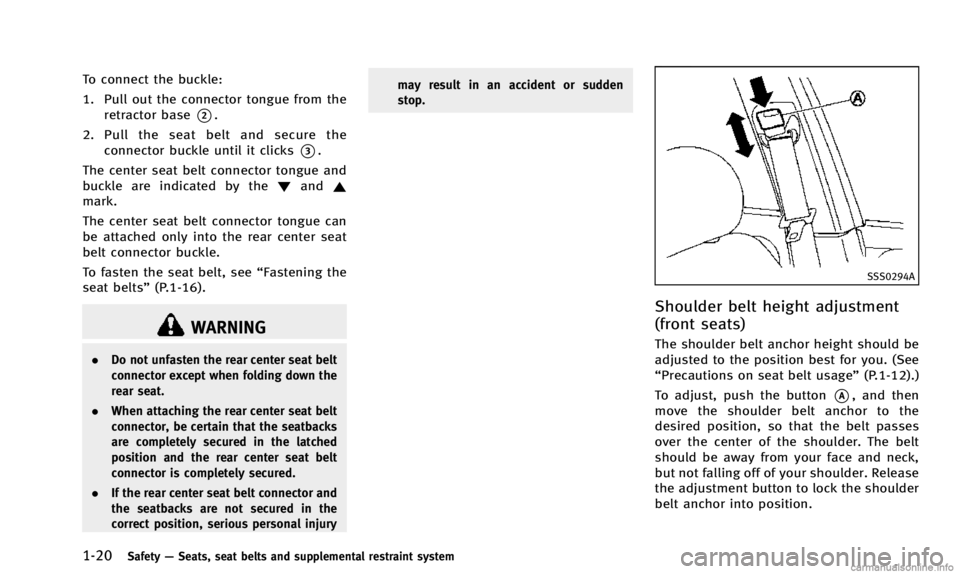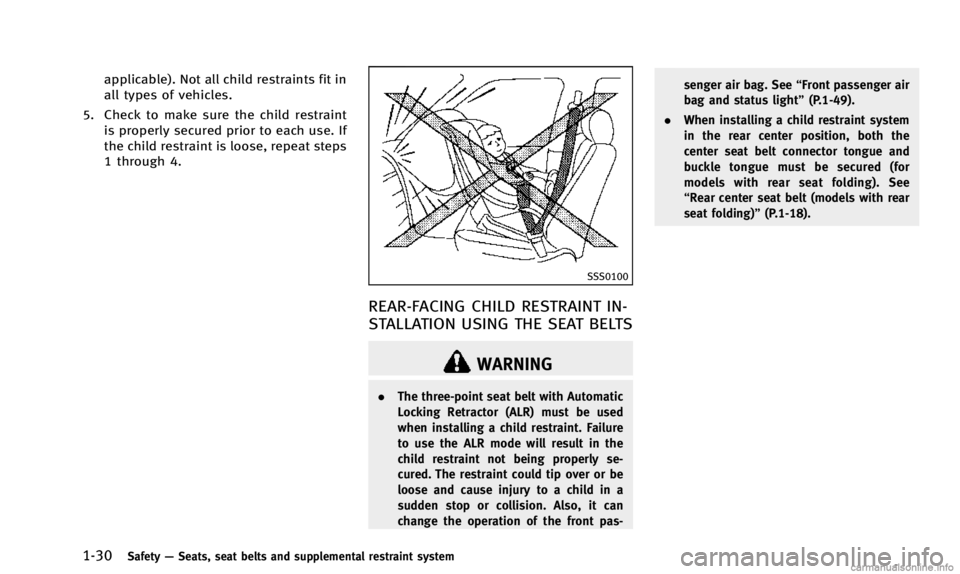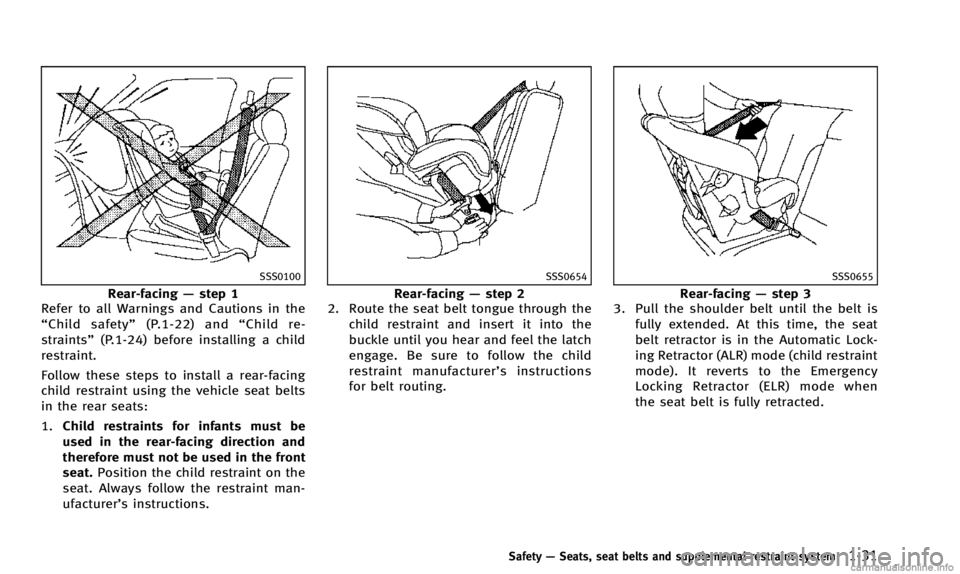lock INFINITI Q50 2014 User Guide
[x] Cancel search | Manufacturer: INFINITI, Model Year: 2014, Model line: Q50, Model: INFINITI Q50 2014Pages: 394, PDF Size: 1.99 MB
Page 30 of 394

JVR0259X
For non-adjustable head restraint/head-
rest
Make sure the head restraint/headrest is
positioned so the lock knob is engaged in
the notch before riding in that designated
seating position.
SSS1035
Raise
To raise the head restraint/headrest, pull it
up.
Make sure the head restraint/headrest is
positioned so the lock knob is engaged in
the notch before riding in that designated
seating position.
SSS1036
Lower
To lower, push and hold the lock knob and
push the head restraint/headrest down.
Make sure the head restraint/headrest is
positioned so the lock knob is engaged in
the notch before riding in that designated
seating position.
Safety—Seats, seat belts and supplemental restraint system1-11
Page 34 of 394

not be able to retract the seat belt. After a
few minutes, the motor normally reacti-
vates and retracts the seat belt. If the seat
belt still cannot be retracted by the motor,
the pre-crash seat belt system has a
malfunction. Have your INFINITI retailer
check and repair the system.
THREE-POINT TYPE SEAT BELT
WARNING
.Every person who drives or rides in this
vehicle should use a seat belt at all
times.
. Do not ride in a moving vehicle when the
seatback is reclined. This can be danger-
ous. The shoulder belt will not be
against your body. In an accident, you
could be thrown into it and receive neck
or other serious injuries. You could also
slide under the lap belt and receive
serious internal injuries.
. For the most effective protection when
the vehicle is in motion, the seat should
be upright. Always sit well back in the
seat with both feet on the floor and
adjust the seat belt properly.JVR0256X
Models with rear seat folding
WARNING
Do not allow children to play with the seat
belts. Most seating positions are equipped
with Automatic Locking Retractor (ALR)
mode seat belts. If the seat belt becomes
wrapped around a child’s neck with the ALR
mode activated, the child can be seriously
injured or killed if the seat belt retracts and
becomes tight. This can occur even if the
vehicle is parked. Unbuckle the seat belt to
release the child. For the center of the rear
seat on the models with rear seat folding,
the connector tongue
*1may also be released. Release the connector tongue by
inserting a suitable tool (such as a key) into
the connector buckle
*A. If the seat belt
can not be unbuckled or is already un-
buckled, release the child by cutting the
seat belt with a suitable tool (such as a
knife or scissors) to release the seat belt.
Safety —Seats, seat belts and supplemental restraint system1-15
Page 35 of 394

1-16Safety—Seats, seat belts and supplemental restraint system
SSS0292
Fastening the seat belts
1. Adjust the seat. (See “Seats”(P.1-2).)
2. Slowly pull the seat belt out of the retractor and insert the tongue into the
buckle until you hear and feel the latch
engage.
.The retractor is designed to lockduring a sudden stop or on impact.
A slow pulling motion permits the
belt to move, and allows you some
freedom of movement in the seat.
.If the seat belt cannot be pulledfrom its fully retracted position,
firmly pull the belt and release it. Then smoothly pull the belt out of
the retractor.
SSS0290
3. Position the lap belt portion
low and
snug on the hips as shown.
4. Pull the shoulder belt portion toward the retractor to take up extra slack. Be
sure the shoulder belt is routed over
your shoulder and across your chest.
The three-point type seat belts have two
modes of operation:
. Emergency Locking Retractor (ELR)
. Automatic Locking Retractor (ALR)
The Emergency Locking Retractor (ELR)
mode allows the seat belt to extend and
retract to allow the driver and passengers
some freedom of movement in the seat.
Page 36 of 394

The ELR locks the seat belt when the
vehicle slows down rapidly or during
impacts.
The Automatic Locking Retractor (ALR)
mode (child restraint mode) locks the seat
belt for child restraint installation.
When the ALR mode is activated the seat
belt cannot be extended again until the
seat belt tongue is detached from the
buckle and fully retracted. The seat belt
returns to the ELR mode after the seat belt
fully retracts. For additional information,
see“Child restraints” (P.1-24).
The ALR mode should be used only for
child restraint installation. During normal
seat belt use by an occupant, the ALR
mode should not be activated. If it is
activated, it may cause uncomfortable seat
belt tension.
WARNING
When fastening the seat belts, be certain
that seatbacks are completely secured in
the latched position. If they are not com-
pletely secured, passengers may be injured
in an accident or sudden stop.
SSS0326
Unfastening the seat belts
To unfasten the seat belt, push the button
on the buckle. The seat belt automatically
retracts.
Checking seat belt operation
Seat belt retractors are designed to lock
seat belt movement by two separate
methods:
. When the belt is pulled quickly from the
retractor.
. When the vehicle slows down rapidly.
To increase your confidence in the seat
belts, check the operation as follows: .
Grasp the shoulder belt and pull
forward quickly. The retractor should
lock and restrict further belt movement.
If the retractor does not lock during this
check or if you have any question about
seat belt operation, see an INFINITI retailer.
Safety —Seats, seat belts and supplemental restraint system1-17
Page 39 of 394

1-20Safety—Seats, seat belts and supplemental restraint system
To connect the buckle:
1. Pull out the connector tongue from the
retractor base
*2.
2. Pull the seat belt and secure the connector buckle until it clicks
*3.
The center seat belt connector tongue and
buckle are indicated by the !and ~
mark.
The center seat belt connector tongue can
be attached only into the rear center seat
belt connector buckle.
To fasten the seat belt, see “Fastening the
seat belts” (P.1-16).
WARNING
.Do not unfasten the rear center seat belt
connector except when folding down the
rear seat.
. When attaching the rear center seat belt
connector, be certain that the seatbacks
are completely secured in the latched
position and the rear center seat belt
connector is completely secured.
. If the rear center seat belt connector and
the seatbacks are not secured in the
correct position, serious personal injury may result in an accident or sudden
stop.
SSS0294A
Shoulder belt height adjustment
(front seats)
The shoulder belt anchor height should be
adjusted to the position best for you. (See
“Precautions on seat belt usage
”(P.1-12).)
To adjust, push the button
*A, and then
move the shoulder belt anchor to the
desired position, so that the belt passes
over the center of the shoulder. The belt
should be away from your face and neck,
but not falling off of your shoulder. Release
the adjustment button to lock the shoulder
belt anchor into position.
Page 41 of 394

1-22Safety—Seats, seat belts and supplemental restraint system
JVR0256X
Models with rear seat folding
WARNING
Do not allow children to play with the seat
belts. Most seating positions are equipped
with Automatic Locking Retractor (ALR)
mode seat belts. If the seat belt becomes
wrapped around a child’s neck with the ALR
mode activated, the child can be seriously
injured or killed if the seat belt retracts and
becomes tight. This can occur even if the
vehicle is parked. Unbuckle the seat belt to
release the child. For the center of the rear
seat on the models with rear seat folding,
the connector tongue
*1may also be released. Release the connector tongue by
inserting a suitable tool (such as a key) into
the connector buckle
*A. If the seat belt
can not be unbuckled or is already un-
buckled, release the child by cutting the
seat belt with a suitable tool (such as a
knife or scissors) to release the seat belt.
Children need adults to help protect them.
They need to be properly restrained.
In addition to the general information in
this manual, child safety information is
available from many other sources, includ-
ing doctors, teachers, government traffic
safety offices, and community organiza-
tions. Every child is different, so be sure to
learn the best way to transport your child.
There are three basic types of child
restraint systems:
. Rear-facing child restraint
. Forward-facing child restraint
. Booster seat
The proper restraint depends on the child ’s
size. Generally, infants up to about 1 year
and less than 20 lbs (9 kg) should be
placed in rear-facing child restraints. For-
ward-facing child restraints are available
for children who outgrow rear-facing child restraints and are at least 1 year old.
Booster seats are used to help position a
vehicle lap/shoulder belt on a child who
can no longer use a forward-facing child
restraint.
WARNING
Infants and children need special protection.
The vehicle’s seat belts may not fit them
properly. The shoulder belt may come too
close to the face or neck. The lap belt may
not fit over their small hip bones. In an
accident, an improperly fitting seat belt
could cause serious or fatal injury. Always
use appropriate child restraints.
All U.S. states and Canadian provinces or
territories require the use of approved
child restraints for infants and small
children. See
“Child restraints” (P.1-24).
A child restraint may be secured in the
vehicle by using either the LATCH (Lower
Anchor and Tethers for CHildren) system or
with the vehicle seat belt. See “Child
restraints” (P.1-24) for more information.
CHILD SAFETY
Page 49 of 394

1-30Safety—Seats, seat belts and supplemental restraint system
applicable). Not all child restraints fit in
all types of vehicles.
5. Check to make sure the child restraint is properly secured prior to each use. If
the child restraint is loose, repeat steps
1 through 4.
SSS0100
REAR-FACING CHILD RESTRAINT IN-
STALLATION USING THE SEAT BELTS
WARNING
. The three-point seat belt with Automatic
Locking Retractor (ALR) must be used
when installing a child restraint. Failure
to use the ALR mode will result in the
child restraint not being properly se-
cured. The restraint could tip over or be
loose and cause injury to a child in a
sudden stop or collision. Also, it can
change the operation of the front pas- senger air bag. See
“Front passenger air
bag and status light” (P.1-49).
. When installing a child restraint system
in the rear center position, both the
center seat belt connector tongue and
buckle tongue must be secured (for
models with rear seat folding). See
“Rear center seat belt (models with rear
seat folding)” (P.1-18).
Page 50 of 394

SSS0100
Rear-facing—step 1
Refer to all Warnings and Cautions in the
“ Child safety” (P.1-22) and“Child re-
straints” (P.1-24) before installing a child
restraint.
Follow these steps to install a rear-facing
child restraint using the vehicle seat belts
in the rear seats:
1. Child restraints for infants must be
used in the rear-facing direction and
therefore must not be used in the front
seat. Position the child restraint on the
seat. Always follow the restraint man-
ufacturer’s instructions.
SSS0654
Rear-facing —step 2
2. Route the seat belt tongue through the
child restraint and insert it into the
buckle until you hear and feel the latch
engage. Be sure to follow the child
restraint manufacturer’ s instructions
for belt routing.
SSS0655
Rear-facing —step 3
3. Pull the shoulder belt until the belt is
fully extended. At this time, the seat
belt retractor is in the Automatic Lock-
ing Retractor (ALR) mode (child restraint
mode). It reverts to the Emergency
Locking Retractor (ELR) mode when
the seat belt is fully retracted.
Safety —Seats, seat belts and supplemental restraint system1-31
Page 52 of 394

7. Check to make sure that the childrestraint is properly secured prior to
each use. If the seat belt is not locked,
repeat steps 1 through 6.
After the child restraint is removed and the
seat belt fully retracted, the ALR mode
(child restraint mode) is canceled.
FORWARD-FACING CHILD RESTRAINT
INSTALLATION USING LATCH
Refer to all Warnings and Cautions in the
“Child safety” and“Child restraints” sec-
tions before installing a child restraint.
Follow these steps to install a forward-
facing child restraint using the LATCH
system:
1. Position the child restraint on the seat. Always follow the child restraint man-
ufacturer’s instructions.
SSS0645
Forward-facing web-mounted —step 2
2. Secure the child restraint anchor at-
tachments to the LATCH lower anchors.
Check to make sure the LATCH attach-
ment is properly attached to the lower
anchors.
If the child restraint is equipped with a
top tether strap, route the top tether
strap and secure the tether strap to the
tether anchor point. See “Installing top
tether strap” (P.1-38). Do not install
child restraints that require the use of a
top tether strap in seating positions
that do not have a top tether anchor.
SSS0646
Forward-facing rigid-mounted —step 2
3. The back of the child restraint should
be secured against the vehicle seat-
back.
If necessary, adjust or remove the head
restraint to obtain the correct child
restraint fit. If the head restraint is
removed, store it in a secure place. Be
sure to reinstall the head restraint
when the child restraint is removed.
See “Head restraints/headrests” (P.1-8)
for head restraint adjustment informa-
tion.
If the seating position does not have an
adjustable head restraint and it is
Safety —Seats, seat belts and supplemental restraint system1-33
Page 54 of 394

7. Check to make sure the child restraintis properly secured prior to each use. If
the child restraint is loose, repeat steps
1 through 6.
FORWARD-FACING CHILD RESTRAINT
INSTALLATION USING THE SEAT
BELTS
WARNING
. The three-point seat belt with Automatic
Locking Retractor (ALR) must be used
when installing a child restraint. Failure
to use the ALR mode will result in the
child restraint not being properly se-
cured. The restraint could tip over or be
loose and cause injury to a child in a
sudden stop or collision. Also, it can
change the operation of the front pas-
senger air bag. See “Front passenger air
bag and status light” (P.1-49).
. When installing a child restraint system
in the rear center position, both the
center seat belt connector tongue and
buckle tongue must be secured (for
models with rear seat folding). See
“Rear center seat belt (models with rear seat folding)”
(P.1-18).
SSS0640
Forward-facing (front passenger seat) —
step 1
Refer to all Warnings and Cautions in the
“Child safety” and“Child restraints” sec-
tions before installing a child restraint.
Follow these steps to install a forward-
facing child restraint using the vehicle seat
belt in the rear seats or in the front
passenger seat:
1. If you must install a child restraint in
the front seat, it should be placed in a
forward-facing direction only. Move the
seat to the rearmost position. Child
restraints for infants must be used in
the rear-facing direction and, therefore,
must not be used in the front seat.
Safety —Seats, seat belts and supplemental restraint system1-35